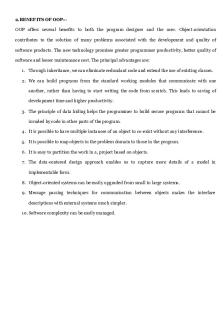Postemployment Benefits PDF

| Title | Postemployment Benefits |
|---|---|
| Course | Accounting |
| Institution | Laguna State Polytechnic University |
| Pages | 2 |
| File Size | 72.9 KB |
| File Type | |
| Total Downloads | 248 |
| Total Views | 544 |
Summary
POSTEMPLOYMENT BENEFITSEmployee Benefits are: a. All forms of consideration (cash or non-cash) given by an entity in exchange for service rendered by employees or for the termination of employment. b. Benefits that are payable after the completion of employment. PE c. Benefits that are expected to b...
Description
POSTEMPLOYMENT BENEFITS Employee Benefits are: a. All forms of consideration (cash or non-cash) given by an entity in exchange for service rendered by employees or for the termination of employment. b. Benefits that are payable after the completion of employment. PE c. Benefits that are expected to be settled wholly before twelve months after the end of the annual reporting period in which the employees render the related service. ST d. Benefits other than short-term employee benefits, post employment benefits and termination benefits. OLT Note: Accounting for employee benefits is heavily on the type of benefit. Type of Employee Benefits: 1. Post-employment (PE) ● Payable after completion of employment. ● Usually part of the remuneration package (total offering of the entity to the employee). 2. Short-term (ST) 3. Other long term (OLT) 4. Termination Post-employment Benefits a. Classification ● Defined Contribution Plan ● Defined Benefit Plan b.
It may be ● contributory or noncontributory Contributory
Noncontributory
Both employee and employer make contributions but they do not necessarily contribute equal amounts. ●
Only the employer.
Funded or unfunded Funded Plan
Unfunded Plan
Entity sets aside funds for future retirement benefits.
Entity retains the obligation . No establishment of separate fund.
Defined Contribution Plan vs Defined Benefit Plan Defined Contribution Plan Actuarial and investment risks fall to employees.
Defined Benefit Plan Actuarial and investment risks fall to the employer
(entity). Accounting: straightforward
Accounting: complex
No actual Assumptions
Requires actuarial assumptions
No actual gains and losses
Possibility of actuarial gains and losses
Normally, undiscounted
Normally, discounted
Expense (P/L): Required contribution
Expense (P/L and OCI): S- service I-interest R- remeasurement
SFP: Not yet paid- accrued Overpayment- prepaid (if it will lead to a reduction in future payments or a cash refund)
Defined Contribution Plan - Contribution: Definite - Benefit: Indefinite - Trustee determines the retirement benefit. Defined Benefit Plan - Contribution: Indefinite - Benefit: Definite
SFP: Underfunded- deficit (accrued) Overfunded- surplus (prepaid)
the insurer does not pay all future employee benefits. Defined Benefit Plan Components of Defined Benefit Cost (PAS 19, paragraph 120) 1.
Service cost (Profit or loss) a. Current service cost b. Past service cost c. Any gain or loss on settlement
2.
Interest (net) (Profit or loss) a. Defined Benefit Obligation b. Plan assets c. Effect of asset ceiling
3.
Remeasurements (OCI) subsequently transferred within equity or reclassified to retained earnings a. Plan assets b. Projected benefit obligation c. Effect of asset ceiling
Postemployment benefit plans under the law a. Social Security System - defined contribution plan - Percentage of salary b. -
R.A. 7641 Defined benefit plan
c. -
Insured benefits Defined contribution plan However, it shall be accounted for as a defined benefit plan if: ● To pay the employee benefits directly when they fall due. ● To pay further amounts if...
Similar Free PDFs

Postemployment Benefits
- 2 Pages

Fringe Benefits Tax
- 3 Pages

benefits of laptop
- 1 Pages

THE Benefits OF Lipstick
- 4 Pages

Benefits of Studying History
- 3 Pages

FAR28 employee benefits UE
- 17 Pages

Benefits of OOPs
- 1 Pages

Benefits of legal technology
- 1 Pages

Non mandatory benefits
- 2 Pages

Benefits reading to students
- 3 Pages

De Minimis Benefits - Tax41
- 2 Pages

Peculiar benefits - Grade: B
- 1 Pages
Popular Institutions
- Tinajero National High School - Annex
- Politeknik Caltex Riau
- Yokohama City University
- SGT University
- University of Al-Qadisiyah
- Divine Word College of Vigan
- Techniek College Rotterdam
- Universidade de Santiago
- Universiti Teknologi MARA Cawangan Johor Kampus Pasir Gudang
- Poltekkes Kemenkes Yogyakarta
- Baguio City National High School
- Colegio san marcos
- preparatoria uno
- Centro de Bachillerato Tecnológico Industrial y de Servicios No. 107
- Dalian Maritime University
- Quang Trung Secondary School
- Colegio Tecnológico en Informática
- Corporación Regional de Educación Superior
- Grupo CEDVA
- Dar Al Uloom University
- Centro de Estudios Preuniversitarios de la Universidad Nacional de Ingeniería
- 上智大学
- Aakash International School, Nuna Majara
- San Felipe Neri Catholic School
- Kang Chiao International School - New Taipei City
- Misamis Occidental National High School
- Institución Educativa Escuela Normal Juan Ladrilleros
- Kolehiyo ng Pantukan
- Batanes State College
- Instituto Continental
- Sekolah Menengah Kejuruan Kesehatan Kaltara (Tarakan)
- Colegio de La Inmaculada Concepcion - Cebu



